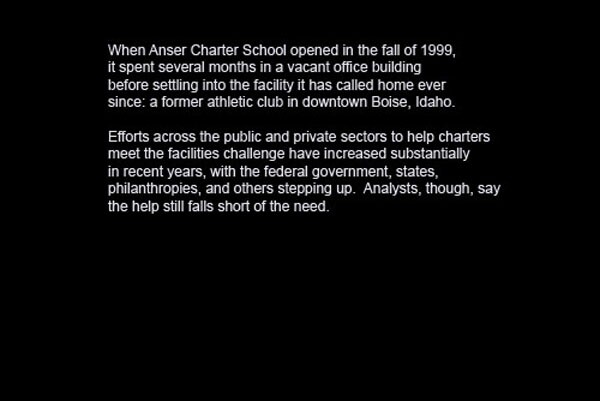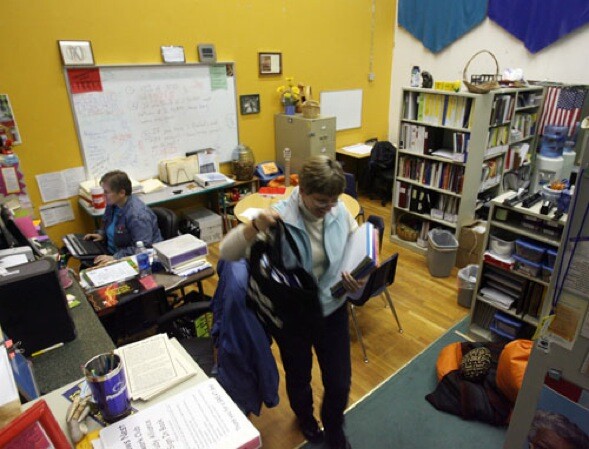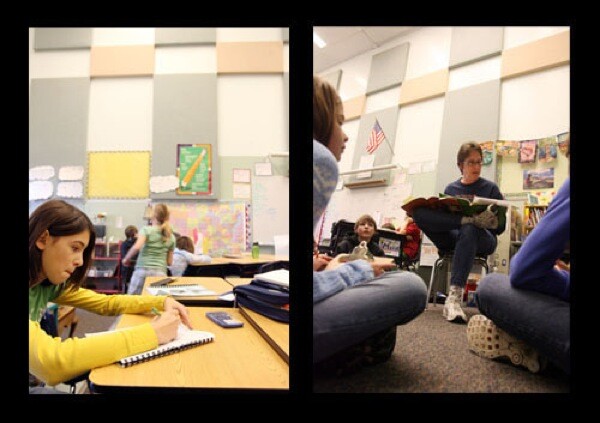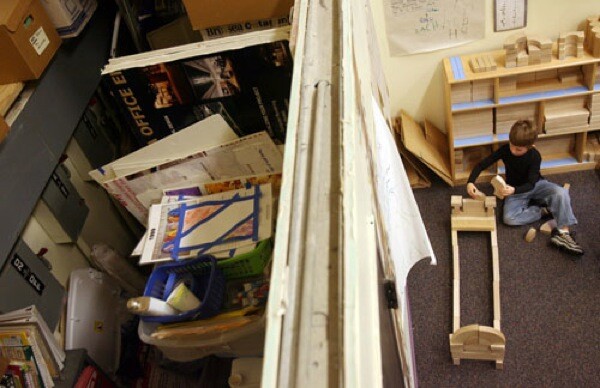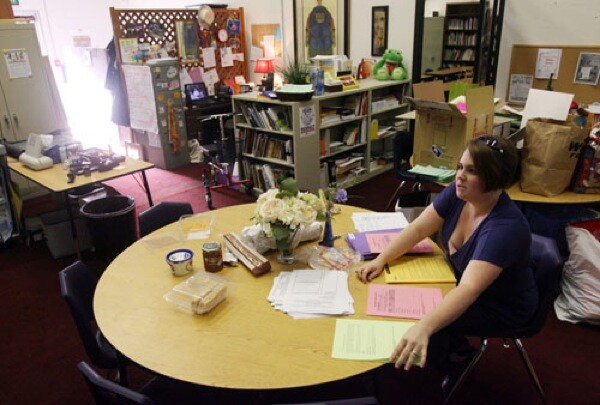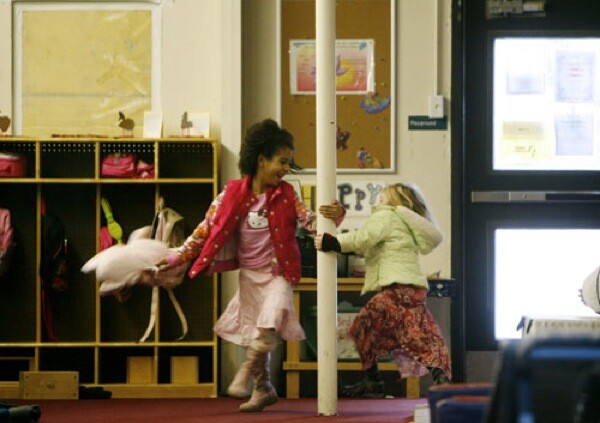When Anser 91��Ƭ����Ƶ School opened in the fall of 1999, it spent several months in a vacant office building before settling into the facility it has called home ever since: a former athletic club in downtown Boise, Idaho.
The classrooms are converted racquetball courts, with 20-foot ceilings and no closets. The school doesn’t have a lunchroom or a gymnasium, and it shares the boxy building with Bronco Elite Gymnastics.
Educating students alongside a gymnastics school poses some unusual challenges, and school administrators are hoping to move to a better space soon.
“One thing that’s really problematic for us is chalk dust, because gymnasts dust their hands,” said Suzanne Burton, the business manager for the 188-student school. “Our students’ cubbies get covered with the dust.”
Welcome to the sometimes strange world of charter school facilities. Many charter operators have had to show considerable creativity and resourcefulness in finding a place to educate their students, whether it’s a former Kmart or car dealership, a church facility, or space in an office complex.
Obtaining and paying for adequate facilities are often big problems for the independent public schools. Those problems are especially acute for new schools not affiliated with larger management organizations that may have more infrastructure, access to money, and other advantages.
Efforts across the public and private sectors to help charters meet the facilities challenge have increased substantially in recent years, with the federal government, states, philanthropies, and others stepping up. Analysts, though, say the help still falls far short of the need.
Just last month, Mayor Sheila Dixon of Baltimore announced city grants of $1 million to help nine charter schools pay for renovation projects. Ohio lawmakers in late 2006 created an unusual incentive for districts to make room for high-performing charters: They can use the test scores of those schools as part of their district ratings under the state’s academic-accountability system.
In California, debates over charter facilities have proved especially intense, playing out in the legislature, the state board of education, and the courtroom, as charter advocates have repeatedly sued districts to force them to share space.
No Bonding Authority
Todd M. Ziebarth, a senior policy analyst at the National Alliance for Public 91��Ƭ����Ƶ Schools, in Washington, said that despite all the activity to help charters, he believes the facilities challenge has expanded along with the charter sector itself. The number of charters has grown from about 2,700 schools serving 670,000 students in the 2002-03 academic year, he estimates, to more than 4,000 schools serving 1.2 million in 2007-08.
“It remains one of the big obstacles for the charter school movement, and if anything, it’s intensified over the last five to seven years,” Mr. Ziebarth said. “Access [to facilities] is a huge issue, but once you find a building, the question is: How do you pay for it?”
The U.S. Department of 91��Ƭ����Ƶ oversees two programs aimed at helping charter schools gain access to facilities.
Provides grant funds on a competitive basis to public and nonprofit entities to develop innovative credit-enhancement models that assist charter schools in leveraging capital from the private sector.
- Since 2001, it has awarded $197 million to 19 entities, including the Illinois Facilities Fund, the Michigan Public 91��Ƭ����Ƶ Facilities Authority, and NCB Capital Impact.
State 91��Ƭ����Ƶ School Facilities Incentive Grants
Provides grants to selected states with per-pupil facilities-aid programs for charter schools. It aims to encourage states to develop and expand such programs and to share in the costs associated with facilities funding.
- Since 2004, it has provided more than $65 million to California, the District of Columbia, Minnesota, and Utah.
SOURCES: 91��Ƭ����Ƶal Facilities Financing Center of the Local Initiatives Support Corp.; U.S. Department of 91��Ƭ����Ƶ
In general, charters face a much tougher time than regular public schools in financing facilities, analysts say. For one, they typically lack access to the most common source of funding school districts use to pay for renovation and construction projects: taxpayer-financed bonds. Also, a majority of states provide no funding to charters for making loan or lease payments.
As a result, most charters must dip into operating dollars to pay facilities costs.
Such expenses typically claim 10 percent to 15 percent of a charter’s operating budget, estimates Bryan C. Hassel, a co-director of Public Impact, a Chapel Hill, N.C.-based educational consulting firm. But no reliable national data are available, he said.
Those costs take a big bite for the . With no state aid for facilities, the school spends about $180,000 each year out of its $1.2 million operating budget for capital expenses, said Ms. Burton, the business manager.
That figure includes both rent and paying loans for improvements made to the building. For instance, it installed acoustic tiles for the otherwise boomy classrooms with their lofty ceilings.
Sixteen states and the District of Columbia provide some form of direct facilities aid to charters, with 11 offering a per-pupil funding source, according to the 91��Ƭ����Ƶal Facilities Financing Center at the New York City-based Local Initiatives Support Corp. Four states and the District of Columbia have their own publicly funded loan programs for charters.
Typically, analysts say, the state aid programs don’t offer enough to cover all costs. Most states with a per-pupil allotment for charters provide less than $1,000 per child, in many cases well below that.
Charters face other obstacles, too. Mr. Hassel says that landlords, lenders, and investors often view charters as high-risk ventures, for several reasons. One is the widespread lack of a dedicated funding source for facilities. Another is that charters receive a limited-term license to operate, typically five years, so lenders see a risk that the schools may close.
An increasingly popular way to help charters—and a method that’s much cheaper than direct aid—is that provide some form of full or partial guarantee for charter schools’ debts, easing the risk for lenders. Those programs help charters get loans, and at more favorable rates.
Such efforts have received support from the U.S. Department of 91��Ƭ����Ƶ, states, philanthropies and others, such as a broad-based initiative in Indianapolis formed in partnership with the mayor’s office.
Private lenders, meanwhile, are gradually becoming more comfortable with making loans to charters, experts in the charter world say. In the early days of the charter movement, “nobody felt comfortable with charter schools because they were new,” said Thomas A. Nida, the chairman of the District of Columbia Public 91��Ƭ����Ƶ School Board and the executive vice president of United Bank, based in Washington. “There was the confusion: What is a charter school? Will they be around for a while?”
Battles in California
In California, debates over charter school facilities have been especially heated.
Charter advocates have sometimes turned to the courts to try to compel districts to share available space. The lawsuits generally hinge on Proposition 39, a statewide ballot initiative approved in 2000 that says public school facilities should be “shared fairly and equally among all public schools, including those in charter schools.”
“With the large school districts, there are only two ways to get their attention: the lawsuits and the press,” said Caprice Young, the executive director of the California 91��Ƭ����Ƶ Schools Association. “We’ve had major battles in Oakland, Los Angeles, and San Diego.”
Note: The Ohio General Assembly has authorized the creation of a revolving-loan program; however, the program has not yet been implemented.
SOURCE: 91��Ƭ����Ƶal Facilities Financing Center of the Local Initiatives Support Corp.
She says the situation has become harder for charters as their numbers steadily increase. “There is not a church or temple in Los Angeles that hasn’t already leased space out to a charter school,” she said.
A superior court judge last summer ordered the 708,000-student Los Angeles school district and charter representatives to enter dispute resolution for a case brought by two charters and Ms. Young’s group. The plaintiffs contend that the district has repeatedly failed to make “reasonable offers of facilities.” An arbitration process was continuing this month. (“Mayor’s Candidates Win Board Seats in L.A.,” May 23, 2007.)
In a 2005 case, a charter school objected to plans by the 5,700-student Sierra Sands Unified School District to place the school’s 223 students in 9½ classrooms at five different sites separated by a total of 65 miles. A state appeals court unanimously ruled in favor of the charter’s effort to seek “reasonably equivalent” facilities from the district. (“Calif. Court Says Charters Deserve Parity in Facilities,” July 27, 2005.)
Last year, charter advocates settled a suit with the San Diego Unified district. The plaintiffs agreed not to appeal a lower-court ruling after they saw the 133,000-student district start to dole out much more space to charters. The space is not free, but costs far less than it would on the open market, said Ms. Young.
Stephanie M. Farland, a senior policy consultant with the California School Boards Association, says she sympathizes with charters’ facilities challenges, but that they “shouldn’t be the districts’ responsibility.”
“If this state is really wanting to push charter schools and have them proliferate, then they should provide for them,” she said.
“We’re all fighting for the same space, the same kids, so it just adds to that contentiousness and competition,” said Kyo Yamashiro, the director of the San Diego district’s school choice office. “It doesn’t necessarily have to be that way, if we had some relief from the state or some outside entity.”
She added, “It’s a really tricky position that districts and charters are put in, pitted against each other even though they don’t want to be.”
But Ms. Young from the California charter schools’ group says it’s only fair for districts to share space. “School districts have to understand that charter schools are public schools,” she said. “If the charters didn’t exist, the kids would be going to noncharter public schools.”
Meanwhile, the state board of education last month, by a 9-2 vote, approved revised regulations on charter facilities that are earning praise from charter advocates but condemnation from some other quarters. The state school boards’ group has warned that it may file a lawsuit to block the regulations, which are under review by the state’s Office of Administrative Law.
One objection concerns the timeline set for processing charter schools’ facilities requests. The school boards’ association charges that the “limited timeline” will pose a hardship for districts. Another concern focuses on limits on districts’ ability to move schools that convert to charters from one facility to another.
Ice Cream Factory
In New York City, a recently established nonprofit organization, Civic Builders, is taking another approach to helping charters. Backed by money from philanthropies, it assumes responsibility for building acquisition, design, and construction of charter schools.
“Charter schools shouldn’t be distracted by real estate, because it’s hard enough to run a school,” said David M. Umansky, the chief executive officer.
Since its launch in 2002, Civic Builders has developed facilities for six schools in the city, and is in the process of developing another, he said. In most cases, it leases the facilities to tenant charters.
“We’ve bought an ice cream factory, a parking facility,” Mr. Umansky added.
Other recently formed nonproft organizations doing similar work include Pacific 91��Ƭ����Ƶ School Development, based in Huntington Park, Calif., and EdBuild, based in Washington.
Mr. Umansky says the New York City school system has been helpful in sharing space in district-owned facilities. And as part of its $13 billion capital-outlay budget for fiscal 2005-09, the 1.1 million-student district allocated $250 million for the support and development of new charter school facilities. Such aid from districts is still rare, though.
In Colorado, a broad-based commission convened last summer by the Colorado League of 91��Ƭ����Ƶ Schools is working to identify shortcomings of the charter-facilities landscape in that state and to draw up a blueprint of public-policy and private-sector assistance.
“We’re looking at everything,” said Jim Griffin, the charter league’s executive director. “We want to improve accessibility to facilities, as far as barriers to the market, barriers to land, improving the financing arrangements. … And then we want to improve or generate new revenue sources.”
Mr. Griffin argues that facilities remain the biggest “limiter” to expanding individual charter schools and the charter sector as a whole. Too many charters lack high-quality facilities, he says.
“It impacts learning; it impacts conditions for kids,” Mr. Griffin said of the inadequacy of many charter facilities. “Just because a charter can thrive in a strip mall doesn’t make that too aspirational. You don’t want to have to settle for that.”

